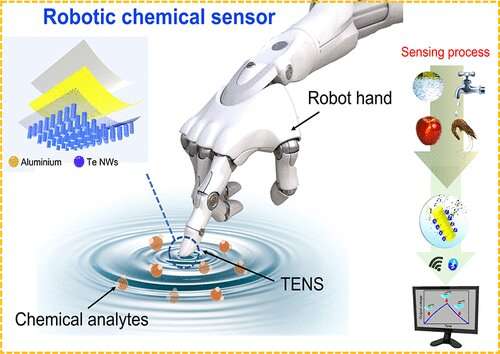This new sensor can detect mercury ions with just a tap

Although many measures are in place to prevent contamination, pollutants such as mercury and lead can still end up in the environment. Sensing them often requires complicated processes, but what if you could detect them with the tap of a fingertip? Researchers reporting in ACS Nano have developed a self-powered nanosensor that can discover small amounts of mercury ions and immediately report the result.
Mercury in its Hg2+ form can be harmful if consumed through contaminated water or food, so researchers have developed various mercury sensors. One of these was integrated into a glove for on-site monitoring, but it couldn’t detect the ion in small amounts and required a constant supply of external power.
Instead, attention is now turning to self-powering systems, such as those driven by the triboelectric effect—a form of static electricity. Not only does this generated electricity keep the device running, but its voltage can be used to signal the presence of a particular analyte. These devices are known as triboelectric nanosensors (TENS). So, Zong-Hong Lin and colleagues wanted to create a TENS that could accurately detect small amounts of mercury ions simply by touching a sample.
To fabricate their TENS, the team used an array of mercury-sensitive tellurium nanowires. This made their sensor highly selective, allowing it to pick out its target even in complicated samples. The researchers mounted the TENS onto the fingertips of a robotic hand and repeatedly touched it into a sample solution. The change in voltage was wirelessly transmitted to a smartphone in real time, corresponding to the presence or absence of mercury ions.
The robotic sensor also successfully detected ions in both naturally sourced and tap water with the same “tapping” method. It also detected them in food, including a shrimp and an apple, after they had been spiked with the contaminant. The researchers say that their TENS could serve as the basis for similar devices to monitor other pollutants remotely and safely.
More information:
Snigdha Roy Barman et al, Triboelectric Nanosensor Integrated with Robotic Platform for Self-Powered Detection of Chemical Analytes, ACS Nano (2023). DOI: 10.1021/acsnano.2c10770
Citation:
This new sensor can detect mercury ions with just a tap (2023, February 22)
retrieved 23 February 2023
from https://phys.org/news/2023-02-sensor-mercury-ions.html
This document is subject to copyright. Apart from any fair dealing for the purpose of private study or research, no
part may be reproduced without the written permission. The content is provided for information purposes only.
For all the latest Science News Click Here
For the latest news and updates, follow us on Google News.

